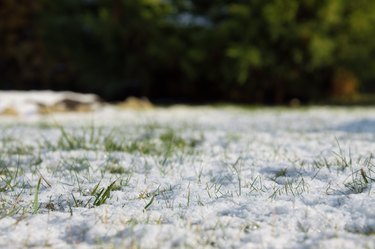
Grass seeds enjoy rich, moist soil, like most plants, but how well they can deal with temperatures depends largely on the type of grass. Some kinds are more fitted to growing in colder climates where there is a higher chance of snow, while others are easily weakened by snowfall. Grass should usually be planted in rainy seasons when it has plenty of time to grow, but there are exceptions, and some kinds of grass can even be planted in the snow.
Normal Seed Planting
Video of the Day
Many types of grass seed are very sensitive to cold. Grass seed is designed to sprout in response to moisture and the proper soil and other environmental conditions. Planting many different kinds of grass seed over snow will cause the seed to hold off from extending roots and create growing problems. The snow can also sometimes damage delicate grass seed shells, rendering the seed useless. In general, the grass seed may survive but delay its sprouting time. If the seed has already sprouted, the snow could easily kill the seedling.
Video of the Day
Planting Before Snowfall
Some gardeners advise sowing grass seed immediately before a snowfall. The idea is that the snowfall will provide a protective covering over the ground, and when it melts, the moisture will seep into the soil and provide a good growing environment for the seeds. This can work in more mild climates where the first snowfall is likely to melt and the ground has not frozen yet, but it is less effective in harsher climates.
Cool-Season Grasses
There are several types of grass that are classified as "cool-season grasses" and are designed to be planted in winter, while there is still snow on the ground. The intention with these types of grasses is to "hibernate" the seed for a short period before spring comes and the snow melts, through a process called dormant seeding. The melting snow carries the grass seeds deep down into the cracks of the soil created by the cold conditions, where it begins to grow.
Seed Planting Considerations
One problem with cool-season grass seed sowing is that it leaves the seed exposed in the snow for a long period of time, sometimes several weeks. This gives plenty of time for hungry birds and other animals to find and eat the seeds. There is also a possibility that the soil will still be too cold and compact to provide enough room for the grass roots. The varieties that can be cool-season planted are also few in number — fescues, bluegrasses and perennial fescues are typically the only options.
Soil Conditions for Grass Seed
If the grass seed is to be planted in a fresh bed of soil, make sure the soil is light and has plenty of air. Dense soil will not give the grass enough room to grow and will not absorb moisture easily. The seeds should be covered with an inch or two of soil after planting. If planting over snow, scatter more grass seed than when planting in soil to compensate for the seed that will be eaten or lost.